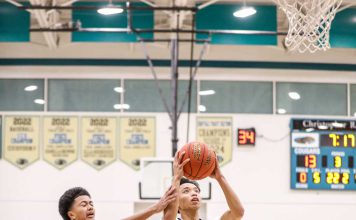Phil Mickelson’s out-of-nowhere victory at the Shell Houston
Open on Sunday catapulted him into the role of favorite to win the
Masters this week.
By Gary D’Amato – Milwaukee Journal Sentinel
Phil Mickelson’s out-of-nowhere victory at the Shell Houston Open on Sunday catapulted him into the role of favorite to win the Masters this week.
The mystery that is Tiger Woods promises to produce plenty of headlines and CBS close-ups at Augusta National.
There is international intrigue, too, with Germany’s Martin Kaymer, England’s Lee Westwood and Luke Donald and Northern Ireland’s Graeme McDowell occupying four of the top five spots in the world ranking.
And, oh yeah, save some pre-tournament salivation for pro golf’s young rock stars: Rickie Fowler, Jhonattan Vegas and Rory McIlroy, to name but three.
All of which allows 44-year-old Steve Stricker of Madison, Wis., to fly under the radar, which is exactly the airspace he prefers.
Stricker goes into his 11th Masters neither the betting favorite nor a red-hot player, but his experience, consistency and superb short game should not be underestimated.
He leads the PGA Tour with 29 consecutive cuts made and ranks sixth in putting average and eighth in scoring average.
He also ranks first in scrambling and fourth in putting from 5 to 15 feet. Those are key statistics at Augusta National, where getting up and down for par and making a high percentage of 8- and 10-foot putts are crucial to success.
Plus, Stricker has some confidence, having finished fourth in Houston, his third top-10 in six starts this year.
“I hadn’t played for a couple weeks, so it was good,” he said Monday after playing a nine-hole practice round with fellow cheesehead Jerry Kelly. “I hit a lot of greens three out of the four days and putted pretty decent. I did a lot of good things.”
But Stricker has played in enough Masters to know a good week in Houston doesn’t mean much when a player drives down Magnolia Lane. Few courses in the world examine every facet of a golfer’s game the way Augusta National does.
“I’ve got some confidence from last week, which is good,” he said. “But I don’t take anything for granted here. It’s a scary place. It’s a place where you’ve got to be on your toes at all times and you have to pay attention, because any hole can come up and grab you.
“So I feel good about last week but yet I know what this place is all about. It’s another set of circumstances and challenges that lie ahead of you. It’s a totally different course.”
Stricker’s best Masters finish was a tie for sixth in 2009 and he also tied for 10th in 2001 and tied for 19th in 2000. But he has missed the cut five times in 10 starts.
“You can have it figured out and understand some of the places to hit it and understand your game plan, but you have to hit it well here,” he said. “You need all parts of your game. You need to drive it well because it’s gotten much tighter. Length is a big deal here. And you need to hit great iron shots.
“I don’t know if anybody ever feels totally comfortable going around here. There’s such a fine line there between bad shots and good shots.”
Stricker hasn’t won a major championship and doesn’t need one to validate a career that includes nine victories, two PGA Tour comeback player of the year awards and two Ryder Cup teams. But it’s the one big goal left for him.
“We talk frequently about this stuff,” said two-time U.S. Open champion Andy North, who has known Stricker for years. “If he were to win a major this year, we might never see him again. He might grow a beard to disguise himself and sit in a deer stand for the next 30 years.”
Though only a handful of players have won majors in their mid-40s, North said he thought Stricker still had a few years of great golf left in him.
“I think he has a window of about the next dozen majors that he can be competitive in,” North said. “His short game is so good there’s no reason he can’t win one. He’s contended in all of them.
“I think he’s figured it out much better the last few years about how to prepare. He understands himself so well now. It’s a matter of him getting it together the right week, and then you have to make that 15-foot par save when you hit a (bad) shot. He can still do that.”













